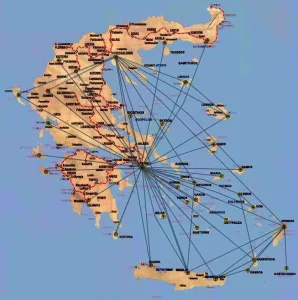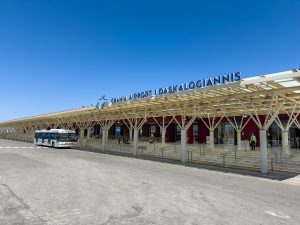Greece has long been a top destination for foreign property buyers, offering a combination of natural beauty, cultural heritage, and lifestyle appeal. However, one factor that has historically shaped the feasibility of property investment is accessibility. Efficient air connectivity directly influences the ability of buyers to conduct site visits, manage properties remotely, and attract short-term renters. This article explores how enhanced air connectivity in Greece is reshaping international investments in real estate. It also examines which regions benefit most and what this means for both short-term rental markets and long-term property values.
Greece as a Real Estate Destination
The Greek real estate market continues to attract an increasing number of international investors, as reflected in 2025 statistics. Factors such as lifestyle, tourism potential, and investment-friendly policies like the Golden Visa program are incentives for foreign buyers to invest in Greece (watch our guide on the Golden Visa program).
Air Connectivity in Greece: Before and After
It may surprise you, but Greece has more international airports than most other European countries. In fact, Greece has 15 international airports that welcome direct flights from abroad by regular and charter airlines. There are also 20 regional airports, making travel throughout the country easy.
Historically, limited access to remote islands or less-served regions created challenges for both investors and travellers, including longer travel times and logistical difficulties in property management. Greek airports outside Athens and Thessaloniki offered limited international connections, with seasonal flights and fewer direct routes to smaller islands. This constrained foreign investment in those regions and limited rental income opportunities. It is understandable that a direct flight to an island greatly facilitates the visitor’s life and experience, rather than having to land in a Greek city like Athens or Thessaloniki first.
Over the past decade, significant upgrades to Greece’s airport infrastructure, particularly at regional airports across the country, have transformed the way investors approach the market. These improvements include modernised terminals, expanded capacity, and increased direct flights from key European hubs. As a result, some routes now operate year-round rather than only during the peak summer months. A key player in this process is Fraport Greece, a subsidiary of the German company Fraport AG, which manages Frankfurt Airport and airports in many other countries worldwide, such as Turkey and Brazil. Fraport Greece manages and develops 14 regional airports across the country.
The other two entities responsible for operating Greek airports that serve public air transport are:
– Athens International Airport
– The Civil Aviation Authority (Alexandroupoli, Araxos, Astypalea, Heraklion, Ikaria, Ioannina, Kalamata, Kalymnos, Karpathos, Kasos, Kastelorizo, Kastoria, Kozani, Kythira, Leros, Lemnos, Milos, Naxos, Nea Anchialos, Paros, Sitia, Skyros, Syros, Chios).

Map of airports in Greece
Regional Airport Upgrades
Several regional airports in Greece have undergone modernisation in recent years, improving both passenger experience and operational efficiency. Upgrades typically include expanded terminals, modernised check-in and security processes, improved baggage handling and better runway and apron capacity.
On April 11, 2017, Fraport Greece took over responsibility for 14 regional airports, including Mykonos and Santorini. The company aimed to upgrade them and expand their operations.
As part of the agreement, Fraport committed to significant investments of more than €400 million over 10 years to upgrade and modernise airport infrastructure. The 14 airports included in the concession agreements are:
– Group A: Aktion (Preveza), Zakynthos, Thessaloniki, Kavala, Corfu, Kefalonia, Chania.
– Group B: Kos, Mykonos, Mytilene, Rhodes, Samos, Santorini, Skiathos.
During the 40-year concession period, Fraport Greece is responsible for the operation, maintenance, and development of these Greek airports, while they remain the property of the Greek state.
Five airports received entirely new terminals, including those in Mykonos, Santorini, and Corfu. Five existing terminals were expanded, while four others underwent modernisation. Improvements led to a 50% increase in terminal sizes at airports like Mykonos and Samos. Twelve runways were completely renovated, enhancing safety and operational efficiency, along with upgrades to the runways and safety zones according to international aviation standards. The fourth phase of runway upgrades is currently underway at airports including Zakynthos, Kefalonia, Corfu, Samos, Rhodes, Mytilene, Mykonos, and Santorini.
Some additional infrastructure improvements that took place include the construction and renovation of 12 fire stations across the airports, the renovation of apron areas, and improvements to airside infrastructure, as well as upgrades to wastewater treatment plants and connections to municipal services. An increase was also recorded in check-in counters and security lanes to handle higher passenger volumes.
The Increase in Passengers Coming to Greece
It is worth noting the increase in passenger numbers arriving in Greece, excluding the coronavirus period. The table below shows statistics from 2022 to 2024:
| Year | Passengers | % Change |
|---|---|---|
| 2022 | 31,194,278 | +79% |
| 2023 | 33,870,868 | +8.6% |
| 2024 | 36,026,347 | +6.4% |
According to company data, 12 of 14 airports managed by Fraport Greece posted positive results in the first half of 2025. Passenger traffic at the 14 regional airports managed by Fraport Greece grew by 2.1% in the first seven months of 2025, reaching 19.5 million passengers compared to 19.1 million in the same period of 2024. June and July 2025 also saw an improvement compared to 2024.
Impact on Foreign Real Estate Buyers in Greece
Enhanced airport connectivity directly affects foreign real estate buyers in several ways:
– With regular, year-round flights, owners can use their holiday home spontaneously, even for a short weekend, while family and friends also benefit from easier access, making the property a vibrant hub for visits and gatherings.
– More frequent and direct flights bring higher tourist numbers to the islands, increasing the pool of potential renters for owners who choose to let their property.
– Improved air connectivity makes the islands more accessible and attractive, boosting demand for properties and enhancing their long-term market value for both resale and rental purposes.
Future trends
Accessibility is key for both buyers and sellers, as we explained in a previous blog post about ferries in Greece. Sustainability initiatives, such as better traffic management and energy-efficient airport operations, can significantly influence future investment trends. The trend toward enhanced access makes the Greek market more geographically diversified and appealing for international buyers.
Air connectivity in Greece is expected to continue improving, as international airlines expand their routes in famous Greek cities and islands both during the summer season and throughout the year. With recent announcements, there are now several flights connecting foreign cities straight to Greek islands, improving accessibility and travel options. For instance, starting September 17, 2025, Dutch air carrier Transavia opens bookings for its summer 2026 season (April 1–October 25), adding new destination routes from Amsterdam to Skiathos, Lesvos & Karpathos.
Finnair, the flag carrier of Finland, will begin scheduled flights from Helsinki to Kos in summer 2026, converting it from charter-only to a regular service. Starting May 2, 2026, Finnair will operate two weekly flights between Helsinki and Kos, continuing until October 24, 2026. With the addition of Kos, Finnair strengthens its presence in Greece, complementing existing routes to Chania, Heraklion, Rhodes and Santorini.
Speaking of the US, in the summer of 2026, there will be a new route from Dallas Fort Worth to Athens, starting on May 21.
These additions make it easier for foreign buyers and visitors to reach the islands directly, reducing travel hassle and opening up new possibilities for shorter trips or more frequent visits.
Faster, more frequent, and reliable flights make even remote regions accessible, increasing investment appeal. Connectivity in Greece is no longer a limiting factor but a strategic advantage. Understanding how air connectivity shapes property trends is key to identifying high-potential locations and making informed investment decisions in Greece’s evolving real estate market.




































